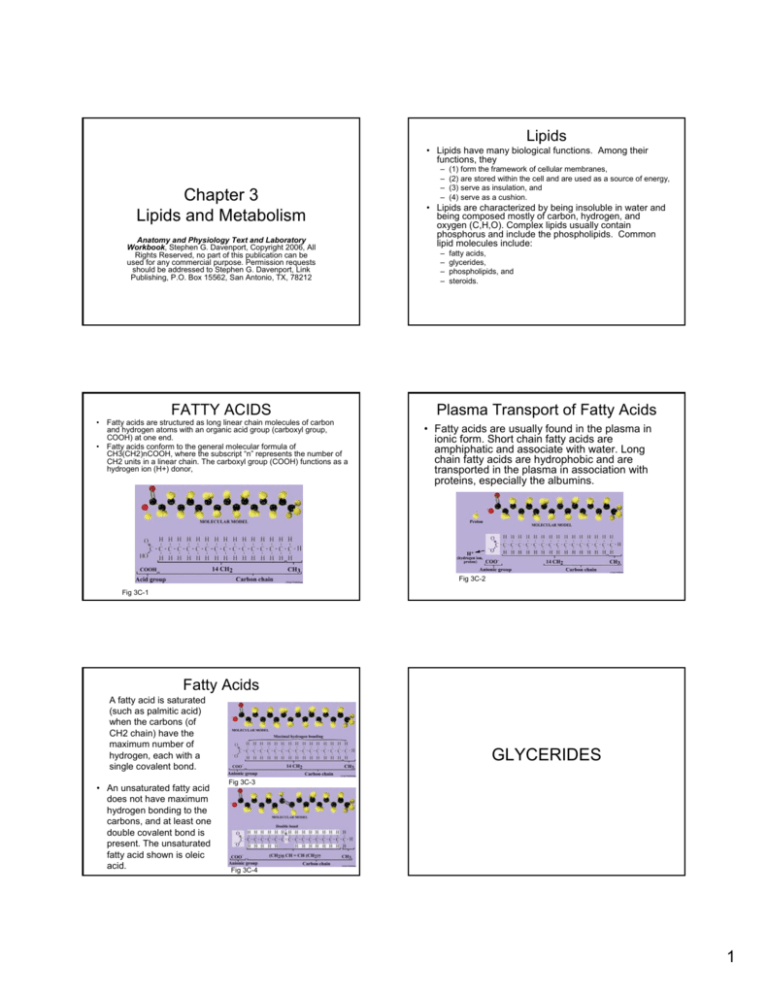
Lipids
• Lipids have many biological functions. Among their
functions, they
Chapter 3
Lipids and Metabolism
Anatomy and Physiology Text and Laboratory
Workbook, Stephen G. Davenport, Copyright 2006, All
Rights Reserved, no part of this publication can be
used for any commercial purpose. Permission requests
should be addressed to Stephen G. Davenport, Link
Publishing, P.O. Box 15562, San Antonio, TX, 78212
FATTY ACIDS
•
•
Fatty acids are structured as long linear chain molecules of carbon
and hydrogen atoms with an organic acid group (carboxyl group,
COOH) at one end.
Fatty acids conform to the general molecular formula of
CH3(CH2)nCOOH, where the subscript “n” represents the number of
CH2 units in a linear chain. The carboxyl group (COOH) functions as a
hydrogen ion (H+) donor,
–
–
–
–
(1) form the framework of cellular membranes,
(2) are stored within the cell and are used as a source of energy,
(3) serve as insulation, and
(4) serve as a cushion.
• Lipids are characterized by being insoluble in water and
being composed mostly of carbon, hydrogen, and
oxygen (C,H,O). Complex lipids usually contain
phosphorus and include the phospholipids. Common
lipid molecules include:
–
–
–
–
fatty acids,
glycerides,
phospholipids, and
steroids.
Plasma Transport of Fatty Acids
• Fatty acids are usually found in the plasma in
ionic form. Short chain fatty acids are
amphiphatic and associate with water. Long
chain fatty acids are hydrophobic and are
transported in the plasma in association with
proteins, especially the albumins.
Fig 3C-2
Fig 3C-1
Fatty Acids
A fatty acid is saturated
(such as palmitic acid)
when the carbons (of
CH2 chain) have the
maximum number of
hydrogen, each with a
single covalent bond.
• An unsaturated fatty acid
does not have maximum
hydrogen bonding to the
carbons, and at least one
double covalent bond is
present. The unsaturated
fatty acid shown is oleic
acid.
GLYCERIDES
Fig 3C-3
Fig 3C-4
1
Glycerides
•
Glycerides are a group of lipids
commonly called fats (solid at room
temperature) and oils (liquid at room
temperature). They are formed from the
union of glycerol and fatty acids.
Monoglyceride
• Monoglycerides are
the simplest structural
glyceride unit. A
monoglyceride is
constructed by
bonding glycerol to a
single fatty acid.
Substituting different
fatty acids produces
different varieties of
monoglycerides.
Fig 3C-6
Fig 3C-1
Fig 3C-5
Diglycerides
• Diglycerides
consist of glycerol
bonded with two
fatty acids.
Different varieties
of diglycerides
are formed by
substitutions of
the fatty acids.
Trilycerides
• Triglycerides consist
of glycerol bonded
with three fatty acids.
Different varieties of
triglycerides are
formed by
substitutions of the
fatty acids.
Fig 3C-8
Fig 3C-7
Adipose Tissue
Glyceride
Dehydration
Synthesis
• Triglycerides are
commonly stored in
adipose tissue. Fat
cells (adipocytes) begin
to enlarge when
triglycerides (identified
as lipid droplets) are
stored within the cell.
As the lipid droplet
continues to enlarge
(dehydration synthesis)
the cytoplasm and
nucleus are seen
displaced next to the
cell membrane.
• A dehydration synthesis
reaction combines two
subunits (molecules) into
a larger unit (molecule)
and produces a molecule
of water.
Fig 3C-10
Fig 3C-9
2
PHOSPHOLIPIDS
• Phospholipids are structured around glycerol and contain
one or more phosphate groups. Their general structure
is similar to a triglyceride except for the replacement of
one of the fatty acid chains with a chain that contains at
least one phosphate group (and usually another group
that is a nitrogen base).
•
The structure of phospholipids makes them
amphiphilic. Amphiphilic molecules are compounds that
consist of a portion having a polar water-soluble group
(hydrophilic, or water loving) that is attached to a waterinsoluble hydrocarbon chain (hydrophobic, or water
fearing).
• In a phospholipid
– the phosphorus containing “head” is hydrophilic and
– fatty acid “tails” are hydrophobic
Phospholipids have a hydrophilic “head” region and a hydrophobic
“tail” region. Fig 3C-12
STEROIDS
Fig 3C-13
Structural model of a cell membrane. Phospholipids form the framework with
their hydrophilic “heads” facing the watery environments and their
hydrophobic “tails” forming the core of the membrane.
• Steroids are fat-soluble lipids that are
characterized by having four hydrocarbon rings.
• A steroid of major importance in the body is
cholesterol.
• Among the functions of cholesterol are both
functional and structural components of cell
membranes, and as a precursor for the
manufacture of many other steroid hormones, and
vitamin D.
Fatty acid anabolism
(in formation of triglycerides)
• In the well-fed state, the most common dietary
fats, the glycerides are digested for absorption
into fatty acids and monoglycerides. Once
absorbed, they are re-synthesized in the
absorptive cells into glycerides (especially
triglycerides). The absorptive cells further
synthesize the glycerides into water-soluble
lipoproteins called chylomicrons. The
chylomicrons are released into the blood and
transported throughout the body. The primary
target of chylomicrons is adipose tissue
Fig 3C-14
Cholesterol, a steroid, is a precursor to many other
steroid hormones, bile salts, and vitamin D.
3
Fig 3C-15
Dietary triglycerides are hydrolyzed (digested) and absorbed by the intestine.
Packaged in the form of water-soluble chylomicrons (lipoproteins), the primary
target of their transport is adipose tissue.
4










